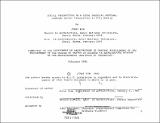Social interaction in a local physical setting : towards social integration in city making
Author(s)
Kim, Jinai
DownloadFull printable version (8.293Mb)
Other Contributors
Massachusetts Institute of Technology. Dept. of Architecture.
Advisor
Edward Robbins.
Terms of use
Metadata
Show full item recordAbstract
A concept of community has greatly influenced the planning ideas of residential areas. Yet, often it has brought a normative view, regarding a local area as some kind of entity. This normative view is intensified by the hierarchy concept of urban structure. This study argues that this normative and hierarchical view hardly incorporates the issue of social integration in residential areas . This study suggests a concept of intermediary structure as a way of reflecting the issue of social integration in a physical environment in residential areas. It emphasizes the interrelation between local areas simply through connecting the interactional webs in a local area, especially that of secondary interaction. This study attempts to see the effect of interaction between different social groups on a local physical setting in four cases. Cases are found in Seoul, Korea. They are examined in terms of allocation of social groups, coincidence between social grouping and physical grouping, physical configuration, and selectivity of use of services to see the possibility of applying the intermediary structure.
Description
Thesis (M.S.)--Massachusetts Institute of Technology, Dept. of Architecture, 1983. MICROFICHE COPY AVAILABLE IN ARCHIVES AND ROTCH Includes bibliographical references (leaves 117-119).
Date issued
1983Department
Massachusetts Institute of Technology. Department of ArchitecturePublisher
Massachusetts Institute of Technology
Keywords
Architecture.